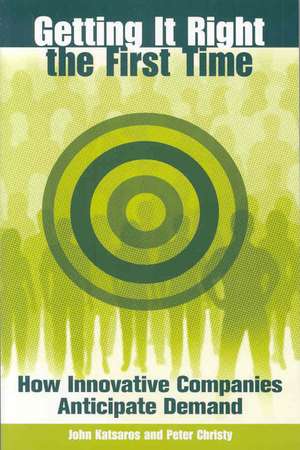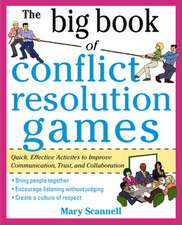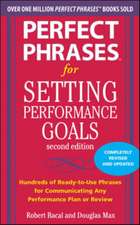Getting It Right the First Time: How Innovative Companies Anticipate Demand
Autor John Katsaros, Peter Christyen Limba Engleză Paperback – 29 mar 2008 – vârsta până la 17 ani
| Toate formatele și edițiile | Preț | Express |
|---|---|---|
| Paperback (1) | 126.61 lei 6-8 săpt. | |
| Bloomsbury Publishing – 29 mar 2008 | 126.61 lei 6-8 săpt. | |
| Hardback (1) | 344.98 lei 6-8 săpt. | |
| Bloomsbury Publishing – 27 feb 2005 | 344.98 lei 6-8 săpt. |
Preț: 126.61 lei
Preț vechi: 164.03 lei
-23% Nou
Puncte Express: 190
Preț estimativ în valută:
24.23€ • 26.33$ • 20.37£
24.23€ • 26.33$ • 20.37£
Carte tipărită la comandă
Livrare economică 21 aprilie-05 mai
Preluare comenzi: 021 569.72.76
Specificații
ISBN-13: 9780313351549
ISBN-10: 0313351546
Pagini: 176
Dimensiuni: 156 x 235 x 14 mm
Greutate: 0.29 kg
Editura: Bloomsbury Publishing
Colecția Praeger
Locul publicării:New York, United States
ISBN-10: 0313351546
Pagini: 176
Dimensiuni: 156 x 235 x 14 mm
Greutate: 0.29 kg
Editura: Bloomsbury Publishing
Colecția Praeger
Locul publicării:New York, United States
Notă biografică
John Katsaros is a principal at the Silicon Valley-based Internet Research Group (IRG), a leading marketing research and consulting company. He is the author of Selling High Tech and a contributing author to Tricks of the Internet Gurus.Peter Christy is a principal at the Silicon Valley-based Internet Research Group (IRG), a leading marketing research and consulting company. He previously served as president of MicroDesign Resources and in management positions at leading computer companies, including Apple, Digital Equipment, IBM, and Sun Microsystems.
Cuprins
PrefaceAcknowledgmentsFace Off: Skating to Where the Puck Will BeAnticipating Change: The Case for Savvy PlanningLooking at the FutureKnowing Where and How to MoveBig PlaysFinding the FuturePositioning for ChangeSegmentation: Finding Your Killer ApplicationFinding the Next Big ThingIndexAbout the Authors
Recenzii
Silicon Valley-based dot-com consultants Katsaros and Christy describe how innovative companies anticipate demand, noting that many start-up companies are too engineer turned entrepreneur and overlook the importance of market research coupled with strategic planning. Arguing that market research in parallel with strategic planning is necessary for business success, they make a strong case for conducting comprehensive, quality research up front and integrating it into a company's strategic planning..[t]he book contains numerous examples of successful and missed opportunities from an array of companies, as well as a short recommended reading list. This volume will be useful for entrepreneurs and business leaders. Additionally, advanced business students and academicians will find its message interesting and informative. Recommended. Upper-division undergraduate through professional collections.
New Markets, New Media Web Addendum [T]o be considered for public and academic library collections. To give your collection more depth..[r]ecommended.
Getting It Right the First Time will interest anyone trying to bring a highly innovative product to market but will be of greatest interest to those in marketing. Although the examples in the book focus on the high-technology industry, the techniques will be useful in any highly innovative situation..[p]oints the way to getting a solid grasp on ill-defined and emerging markets.
Business changes and influences are happening faster and faster, requiring the successful company to be more responsive and anticipatory than ever. For a guide which teaches managers and owners how to predict demand and handle it correctly, Getting It Right The First Time: How Innovative Companies Anticipate Demand is essential. Examples of real-life lucrative successes and missed opportunities alike offer lessons for all, and John Katsaros and Peter Christy have gathered a representative sampling of these case histories to work into a general company plan for marketing and advancement. Recommended for any entrepreneur interested in innovation.
[G]etting It Right the First Time is useful for people who market high-tech or other truly innovative products. The authors give convincing reasons why it pays to include us in the development. They also show that we do have a market research approach that is likely to be worth more than it costs. Companies don't have to suffer so many expensive new product failures. We don't have to sit on the sidelines.
For entrepreneurs, marketers, product developers, and business strategists.
New Markets, New Media Web Addendum [T]o be considered for public and academic library collections. To give your collection more depth..[r]ecommended.
Getting It Right the First Time will interest anyone trying to bring a highly innovative product to market but will be of greatest interest to those in marketing. Although the examples in the book focus on the high-technology industry, the techniques will be useful in any highly innovative situation..[p]oints the way to getting a solid grasp on ill-defined and emerging markets.
Business changes and influences are happening faster and faster, requiring the successful company to be more responsive and anticipatory than ever. For a guide which teaches managers and owners how to predict demand and handle it correctly, Getting It Right The First Time: How Innovative Companies Anticipate Demand is essential. Examples of real-life lucrative successes and missed opportunities alike offer lessons for all, and John Katsaros and Peter Christy have gathered a representative sampling of these case histories to work into a general company plan for marketing and advancement. Recommended for any entrepreneur interested in innovation.
[G]etting It Right the First Time is useful for people who market high-tech or other truly innovative products. The authors give convincing reasons why it pays to include us in the development. They also show that we do have a market research approach that is likely to be worth more than it costs. Companies don't have to suffer so many expensive new product failures. We don't have to sit on the sidelines.
For entrepreneurs, marketers, product developers, and business strategists.












